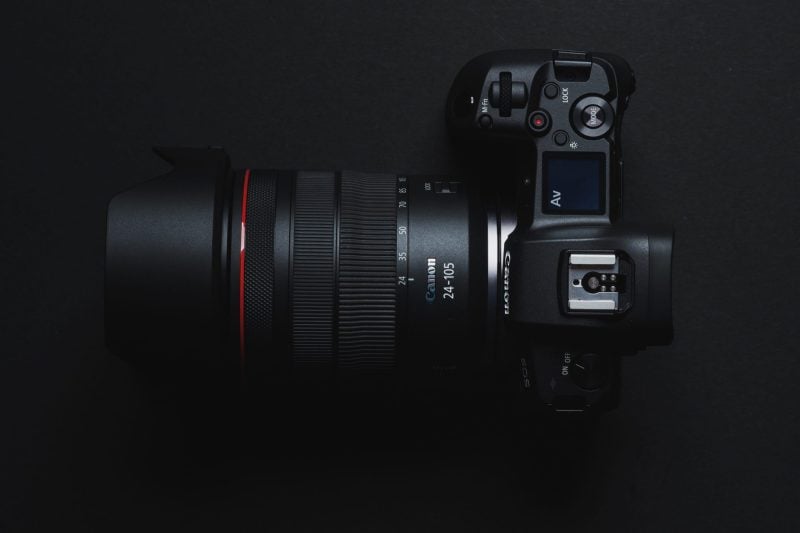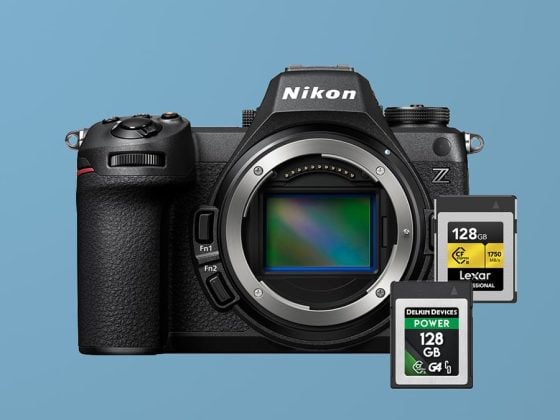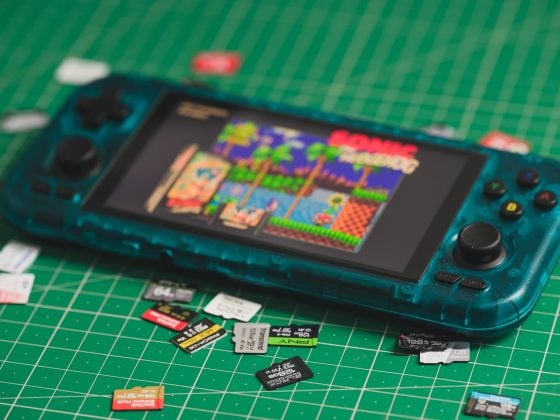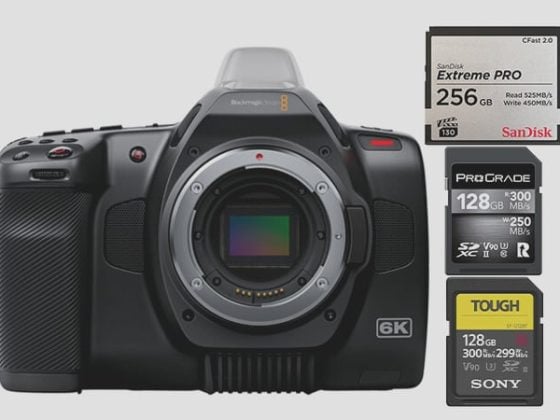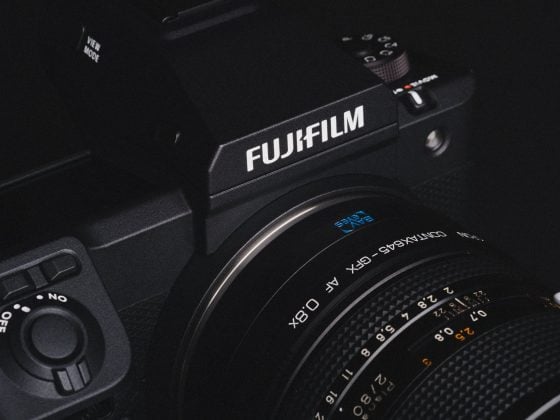The Canon EOS R is no slouch when it comes to data output. With 8fps continuous burst shooting speeds, the Canon R can produce a RAW image data stream of more than 250Mbps, and it doesn’t stop there. Video specs are very data-heavy, with 4 K video having an output of 480Mbps and 1080p video having 180Mbps.
Buying the fastest memory card may be a good idea to get the full benefit of the amazing data output.
The Canon EOS R has a single card slot that supports UHS-II memory cards of any capacity.
Canon EOS R Memory Card Recommendations
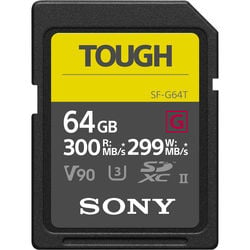 You will need UHS-II memory cards to get the best performance out of the Canon EOS R.
You will need UHS-II memory cards to get the best performance out of the Canon EOS R.
While the V90 memory cards are best for clearing the buffer quickly, the slower V60 cards are great for shooting video since they still offer enough performance for 4 K capture while being significantly more affordable.
To use the high-quality 480Mbps 4 K video that the EOS R outputs, you need cards with at least 55-60MB/s performance.
| Card Name | In-Camera Speed (EOS R) | See Price |
| UHS-II V90 | ||
| Sony G Tough | 98.22MB/s | Amazon |
| Sandisk Extreme Pro 300MB/s | 97.39MB/s | Amazon |
| ProGrade V90 | 97.18MB/s | Amazon |
| Delkin Black | 97.96MB/s | B&H |
| Hoodman Steel 2000x | 97.77MB/s | Amazon |
| UHS-II V60 | ||
| Sony M Tough | 79.70MB/s | Amazon |
Also, check out my list of Accessories Canon R.
Canon EOS R Buffer Tests
There are a few different ways to test the cards that I’ve worked out, but I’ve found the most reliable still is to record a burst sequence and calculate the time the buffer takes to clear. Another method involves counting the shots and data and comparing them to the buffer size. While that method is very fast regarding man-hours of churning through data, I’ve found it not as accurate as it doesn’t account for hiccups, and it’s very difficult to determine the usable size of the buffer. On the Canon R, the usable buffer is somewhere around 835 MB.
Canon EOS R Specs
| Sensor: Full Frame 30.3MP CMOS Processor: Digic 8 Continuous Shoot: 8fps Est. Buffer Size: 1G – 835MB usable RAW Shots To Fill Buffer: 74 with 24.1 MB shots (Sandisk Extreme Pro UHS-II) Time To Clear Buffer: 7:41 (Sandisk Extreme Pro UHS-II) Variable Size Of RAW Shots: 24-49MB 4k Datarate: 480mbps – 60MB/s 1080p Datarate: 180mbps – 22.5MB/s |
Memory Cards For 4k Video
You only need to be picky with your memory cards when shooting 4k video with the Canon EOS R.
This camera can output 480mbps when shooting 4k video, which translates to 60MB/s.
With 1080p, you can get a bitrate of 180mbps, translating to 22.5 MB/s.
While UHS-I memory cards can produce speeds of 60MB/s or faster, they usually max out at a speed class of U3.
The U3 rating only guarantees a minimum data rate of 30MB/s. So even though you get a Sandisk Extreme Pro that can write at 62MB/s, it may cause issues with very long recordings or degrade over the years and drop in speed.
However . . .
You might be looking at my chart and seeing that some cards produced slower speeds than 60MB/s, but they still worked fine for 4k video. This is because recording a stream of photos takes more processing power and slows down the system more so than video. The processing of shooting photos takes several steps, and the Digic 8 processor limits the multi-threading capabilities of the EOS R. The Digic 8 is also not said to be dual or even quad-core like some other cameras. Even still, other brands probably keep all their memory card processing reserved for one core so the other cores can calculate AWB, focusing, and exposure.
This single-core processor is likely why we see limitations with silent shooting and eye AF when in Servo or burst modes.
With a single thread, when each photo is created, the raw data is sent to the buffer and processed before it is sent to the memory card. Each shot is written to the memory card from the buffer, which produces a very small delay as it is processed, slowing down the memory card write speeds seen in my test. It slows down even more if you shoot RAW+JPG, usually by up to 20MB/s, because even more processing has to happen to each image before they are written to the card.
When it comes to writing video, there is no multi-step processing, and the data stream can record the card much faster, but there is no way for me to test this. I would assume that you would probably see a +10MB/s speed increase when just recording video. This is why many of the cards that are listed above with speeds of 50MB/s are still working for me when doing 4k tests; they are recording slightly faster when streaming video from the buffer to the card.
Shooting 1080p
If you plan on shooting only 1080p and you’re not doing much burst photography, a good UHS-I memory card is all you’ll need.
1080p produces a data rate of 180mbps, which translates to 22.5MB/s, and most memory cards, even the slow Evo and Ultra cards, can produce those speeds.
What The Numbers And Letters Mean On Each Card
Every memory card contains a bunch of numbers and letters. These letters change constantly as ratings and speed classes change. As technology becomes more demanding, new codes need to be listed. For example, with micro SD memory cards, you may see A1 and A2. These cards are designed for running mobile applications and games that read and write to memory cards randomly rather than sequentially.
Memory cards for cameras only write sequentially, so there are fewer requirements for these SD memory cards.
Here are the codes you need to know when buying SD memory cards for the Canon R.
U1, U3, v30, v60, v90
These numbers represent the speed class and have to do with the minimum speed of each card.
U1, U3 is 10MBs and 30MB/s respectively.
v30, v60, v90 is 30MB/s, 60MB/s and 90MB/s represents minimum write speeds.
You may also see older cards, say Class 10. These have a minimum of 10MB/s, like U1 cards.
UHS-I vs. UHS-II
UHS-I and UHS-II are other performance classes, but UHS-II requires a compatible camera. The Canon R is UHS-II compatible.
There is a physical difference between UHS-I and UHS-II memory cards. UHS-II cards have a second set of pins. The camera must also have a second set of pins inside the SD card slot to read and write UHS-II cards. UHS-II cards can work in UHS-I cameras, but they will be limited to UHS-I speeds. UHS-I cards can also work in UHS-II cameras but will also be limited to UHS-I speeds.
SDXC / SDHC
SDXC and SDHC have to do with the file system the card can handle.
SDHC cards will always be 32GB or smaller and will only be able to record data that is 32-bit. In other words, if you use a 32GB card that is SDHC, you will be limited to a fat32 file system and a 4GB file size limit. If you try to record video to a 32-bit card, the files are broken into 4GB chunks.
SDXC uses an exFat filesystem that is 64-bit. If you record video to a 64-bit card, you will be able to record video clips larger than 4GB as a single clip.
Canon EOS Tips
Can You Use Micro SD Memory Cards In The EOS R?
I often get this question, so I tested various micro SD memory cards in various cameras.
I’ve found that many micro SD memory cards are capable of matching the speeds of the bigger brother, however, a lot of micro SD memory cards still run slower so it depends on the brand and the model.
The problem with micro SD memory cards is that you have to use an adapter, which is a weak link.
While I’ve found that micro SD memory cards can perform very well, I’ve found that adapters often cause issues. Cards can vibrate and lose connection with the adapter, or some adapters are just bad.
Because of this, I do not recommend you use micro SD cards unless it’s an emergency. If you’re shooting regularly, you should buy an SD memory card for your Canon R to avoid memory card problems.
This doesn’t mean you should never use Micro SD cards. I shoot with GoPros, drones, and various cameras, so I like to keep a backup micro SD card in my bag because it will work on any device just in case I ever kill a card or forget one.
Formatting Your Cards
You should always format your memory cards in the Canon EOS R for the best performance. Formatting your cards in other devices before using them in the Canon can cause issues. I’ve had so many issues with the DJI Mavic Pro 2 because of this. You must format the cards in the Camera.
If, for whatever reason, the camera does not recognize the card, try formatting it again in different systems until you can get it to work. For example, cards that didn’t work in my Mavic 2 Pro, I had to in a GoPro Hero 7 first. When they were formatted on an Android phone, they would not work.
I’ve never seen this issue in Canon, but it’s still a good idea to always format in camera.
| **This website contains affiliate links. We will earn a small commission on purchases made through these links. Some of the links used in these articles will direct you to Amazon. As an Amazon Associate, I earn from qualifying purchases. |

